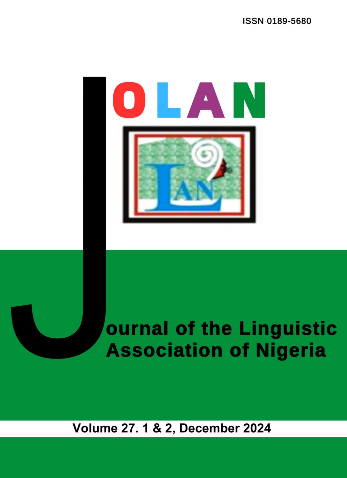Persuasive Functions of Metaphor in Selected Government Ministers’ Interactions with Nigerian Citizens
Keywords:
metaphor, politics, discourse, persuasion, interactionAbstract
Formal government minister-public interactions are recent political and democratic events in Nigeria designed to inform people about government policies and actions and appeal for positive responses.
Existing literature on political discourses have concentrated on ceremonial speeches, campaigns,
manifestoes, and parliamentary debates with little attention paid to the peculiar use of metaphors in
government ministers-public interactions in Nigeria This study therefore examined discursive issues
and metaphor use in selected government minister-public interactions in Nigeria to determine their
persuasive function(s). Charteris-Black’s Critical Metaphor Analysis was adopted to explain metaphor
and Brown’s Persuasive Techniques to determine the functions. Data were from interactions of the
National Good Tour (NGGT) of Nigeria between 2012 and 2014, collected through downloads and
live recordings on radio and television. Texts were transcribed and subjected to Discourse analysis.
Findings revealed discursive to include, nation building, politics/democracy, and citizen’s roles in
nation building. Persuasive functions identified include, response reinforcement, response shaping and
response change of the citizenry to issues identified. These were conceived in metaphors of games and
sports represented in Politics as a contest; movement captured in Politics as a journey; building, which
identified the politicians as builders and the nation as a construction site, and life and death metaphor,
reflecting the nation as ailing. This study increased our understanding of metaphors and how they
enhance persuasion and enrich the language use of public interactions and political discourse
generally. It also increases understanding of the political realities especially in the Nigerian context.
References
Adetunji, A. (2006). Inclusion and exclusion in political, discourse: Deixis in Olusegun Obasanjo’s Speeches’, in Journal of Language and Linguistics 5(2): 177-191. ISSN 1475 – 8989. webspace.buckingham.ac.uk/kbernhardt/journal/5_2/adetunji.htm
Akpan, E. (1987). Rhetoric as a means to sharing meaning’ in Topical Issues in Communication Arts. Ed. Unoh, S.O. Uyo, Modem Bus. Press, pp. 251-260,
Alo, M.A. (2008). Lexical Choices and Values in Political Manifestoes in Nigeria: in Ibadan Journal of English Studies vol. 5. Ibadan, Dept. of English Uni of Ibadan. Pp. 229-244. https://www.ui.edu.ng/IJES Accessed 15/11/17
----------(2010). English Modality as a Rhetorical Tool in Nigerian Political Manifestoes: in Language, Literature and Discourse: A Festschrift in Honour of Prof. A. L. Oyeleye. Pp.127
---------- (2012). A Rhetorical Analysis of Selected Political Speeches of Prominent African leaders in British Journal of Arts and Social Sciences. (BJASS). Vol. 10 No.1 Pp.87-100. www.bjournal.co.uk/paper/BJASS Accessed 15/11/17
Arseneault, M. (2006). Metaphor: Philosophical Theories. Madison, WI, USA. Elsevier.
Awonuga, C. (2005). A stylistic study of Sustenance of Democracy` by Nigeria’s President Olusegun Obasanjo`, in Journal of Social Science, 11 (2) 111-119. journals.sagepub.com/doi/abs/10.1177/1750481313494501 Accessed 25/11/17
Beard, A. (2000). The Language of Politics. London: Rutledge.
Blaney, C. B. (2014). The Language of Political Persuasion: Three Case Studies Exploring “Rhetoric of Coercion” M.A thesis submitted at the John Hopkins University, Baltimore, Maryland. https://jscholarship.library.jhu.edu/bitstream/handle/...2/.../BLANEY-THESIS-
p... Accessed 29/11/2017.
Brown, J.A.C. (1963). Techniques of Persuasion: From Propaganda to Brainwashing. London: Cox and Wyman ltd.
Charteris-Black, J. (2005).Politicians and Rhetoric: The Persuasive Power of Metaphor. Basingstoke: Palgrave Macmillan.
----------(2011). Politicians and Rhetoric: The Persuasive Power of Metaphor (2 ed.) Basingstoke: Palgrave Macmillan
Chilton, P. & Schaffner, C. (1997). Discourse and Politics’, in Teun van Djik (ed.), Discourse as Social Interaction. London: Sage
Fairclough, N. (1989). Language and Power. New York: Longman.
Flergin, A. (2014). Language of Persuasion: A Discourse Approach to Advertising Language. Research Journal of Recent Sciences ISSN 2277-2502, Vol. 3(ISC-2013), 62-68 (2014): Available online at: www.isca.in, Accessed 24/11/17.
Goatly, A. (1997). The Language of Metaphors. London: Routledge.
Joseph, J. E. (2006). Language and Politics. Edinburgh: Edinburgh University Press.
Lakoff, G. (1986). A figure of thought’, in Metaphor and Symbolic Activity, 1 (3), 215-225. Available at www.tandfonline.com/doi/abs/10.1207/s15327868ms0103_4
Lakoff, G. & Johnson M. (1980). Metaphors We Live By. Chicago: University of Chicago Press. 1999 Philosophy in the flesh. New York: Basic books.
Obeng, S. G. (1997). Language and Politics: Indirectness in Political Language, in Discourse and Society,8(1): 49-83. ournals.sagepub.com/doi/abs/10.1177/0957926597008001004
Odebunmi, A. (2010). Ideology and body part metaphors in Nigerian English, In Review of Cognitive Linguistics 8:2.John Benjamin Publishing Company. pp. 272-299 https://www.researchgate.net/.
Searle, J.R. (1993). Metaphor. In Ortony, A (ed.) Metaphor and Thought, 2nded. New York. C1 I’ Pp. 83 -111. onlinelibrary.wiley.com/doi/10.1002/9781444304732.refs/pdf. Accessed 30/11/17
Steen, G. (2006). Metaphor: Stylistic Approaches, in Encyclopaedia of Pragmatics, Mey, J. L. 2nd ed. Oxford, Elsevier ltd.Pp.608 - 614.
https://www.elsevier.com/books/...encyclopedia-of-pragmatics/.../978-0-08-096297-9
Taiwo, R. (2008). Metaphors in Nigerian Political Discourse. Nebula: A Journal of Multidisciplinary Scholarship. (http://www.nobleworld.biz.) Accessed 13/11/17
----------(2008). Language Ideology and Power Relations in Nigerian Newspaper headlines. Nebula: A Journal of Multidisciplinary Scholarship. (http://www.nobleworld.biz.)
Van Dijk, (1985). A Handbook of Discourse Analysis: Vol.4. London: London Academic press ltd.
----------(2006). Introduction: Discourse, Interaction and Cognition: Discourse Studies, CA and New Delhi. Sage pub. http://dx.doi.org/10.4135/9781446289068. Accessed 30/11/2017
----------(2006). ’Politics, ideology, and discourse’, in Brown, K. (ed), The Encyclopaedia of language and linguistics. Vol. 9 Oxford; New York: Pergamon Press, pp. 728-740. https://www.elsevier.com/.../encyclopedia-of-language-and-linguistics/brown/978-0-0.
Accessed 30/11/17.
Wang, J. (2010). A Critical Discourse Analysis of Barack Obama’s Speeches; In Journal of Language Teaching and Research, vol. 1, No. 3, Finland: Academy pub. Pp254-261 www.academypublication.com/issues/past/jltr/vol01/03/12.pdf. Accessed 28/11/17
Wilson, J. (2001). Power and Pragmatics, in Encyclopaedia of Pragmatics 2nd ed. Oxford, Elsevier ltd. Pp. 744-747. https://www.elsevier.com/books/...encyclopedia-of-pragmatics/.../978-0-08-096297-9
Wodak, R. and Cillia, R. (2006). Politics and Language: Overview in Encyclopaedia of Pragmatics, Mey, J. L. (ed.) 2nd ed.Oxford, Elsevier ltd. Pp.723-735 https://www.elsevier.com/books/...encyclopedia-of-pragmatics/.../978-0-08-096297-9














